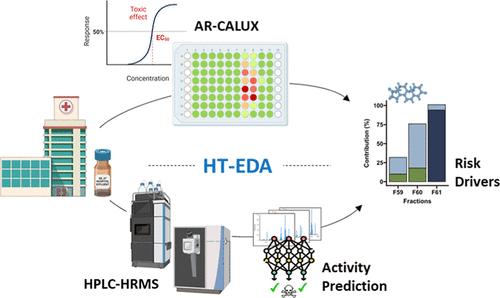医院废水中雄激素化合物的高通量效应导向分析:通过毒性预测支持的非靶标筛选识别效应驱动因素
IF 11.3
1区 环境科学与生态学
Q1 ENGINEERING, ENVIRONMENTAL
引用次数: 0
摘要
释放到环境中的污染物数量不断增加,需要创新的检测和识别策略,特别是在医院废水等复杂的环境基质中。医院污水中含有天然和合成激素,可能会严重影响水生生态系统的内分泌。在这项研究中,利用微孔板分离、AR-CALUX生物测定和高效的数据处理工作流程,HT-EDA已被用于从医院废水中识别主要效应驱动因素(睾酮、雄酮和诺孕酮)。通过非靶向筛选,最初检测到超过5000个特征(ESI+),但我们的工作流程基于雄激素活性预测的优先级将需要进一步分析的特征数量减少了95%以上,大大简化了工作量。此外,半定量非目标分析允许在不需要参考标准的情况下计算鉴定化合物对样品总活性的贡献。虽然这一贡献很低(约4.3%),并且仅适用于一种化合物(1,4-雄二烯-3,17-二酮),但它提供了第一种不依赖标准的计算这一贡献的方法。与现有的替代方案相比,我们的工作流程通过增强HT-EDA来更有效地识别和确定医院废水中影响驱动因素的优先级,从而显示出明确的环境相关性,并且可以适应复杂混合物中的其他环境威胁。本文章由计算机程序翻译,如有差异,请以英文原文为准。

High-Throughput Effect-Directed Analysis of Androgenic Compounds in Hospital Wastewater: Identifying Effect Drivers through Non-Target Screening Supported by Toxicity Prediction
The increasing number of contaminants released into the environment necessitates innovative strategies for their detection and identification, particularly in complex environmental matrices like hospital wastewater. Hospital effluents contain both natural and synthetic hormones that might significantly contribute to endocrine disruption in aquatic ecosystems. In this study, HT-EDA has been implemented to identify the main effect-drivers (testosterone, androsterone and norgestrel) from hospital effluent using microplate fractionation, the AR-CALUX bioassay and an efficient data processing workflow. Through nontargeted screening, over 5000 features (ESI+) were initially detected, but our workflow’s prioritization based on androgenic activity prediction reduced the number of features requiring further analysis by over 95%, significantly streamlining the workload. In addition, the semiquantitative nontarget analysis allowed for the calculation of the contribution of an identified compound to the total activity of the sample without the need for reference standards. While this contribution was low (∼4.3%) and applicable to only one compound (1,4-androstadiene-3,17-dione), it presents the first approach for calculating such contributions without relying on standards. Compared to the available alternatives our workflow demonstrates clear environmental relevance by enhancing HT-EDA for more efficient identification and prioritization of effect-drivers in hospital effluents, and it can be adapted to address other environmental threats in complex mixtures.
求助全文
通过发布文献求助,成功后即可免费获取论文全文。
去求助
来源期刊

环境科学与技术
环境科学-工程:环境
CiteScore
17.50
自引率
9.60%
发文量
12359
审稿时长
2.8 months
期刊介绍:
Environmental Science & Technology (ES&T) is a co-sponsored academic and technical magazine by the Hubei Provincial Environmental Protection Bureau and the Hubei Provincial Academy of Environmental Sciences.
Environmental Science & Technology (ES&T) holds the status of Chinese core journals, scientific papers source journals of China, Chinese Science Citation Database source journals, and Chinese Academic Journal Comprehensive Evaluation Database source journals. This publication focuses on the academic field of environmental protection, featuring articles related to environmental protection and technical advancements.
 求助内容:
求助内容: 应助结果提醒方式:
应助结果提醒方式:


